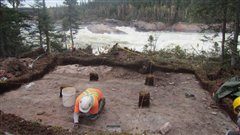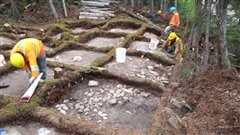I

n central Labrador initial excavation work for the huge Muskrat Falls power plant has uncovered up to 40-thousand ancient Amerindian artefacts.
Several archeological sites along what was an ancient portage route have uncovered arrow heads, bits of knives and tools, some remarkably well-preserved, pottery shards and so on.
Most of the items appear to be of Innu origin and are from a hundreds of years old to 3,000 years old.
Marion Organ, an environmental engineer, said because the area is remote the items and the history would never have been found if it weren’t for the mega project development. The sites were camping areas and fire pits, and two sites seem to indicate that canoe building may have taken place there.

Fred Schwartz, senior archaeologist, says finding the sites and artefacts is important as it puts things in a context.

He says, “What we’re attempting to do is remove the cultural materials from these sites, in such a way that we can reconstruct through photographs … and 3D models, the camp sites. So we have to record every rock that we find.”
He notes that the finding of pottery bits, which he says is rare in aboriginal life in Labrador prior to the arrival of Europeans. He said, while not unknown, mobile hunters and gatherers tended to avoid carrying heavy pottery items.
Recovery work has ended for this year but research will continue as the project proceed before the sites themselves become flooded by the eventual dam.

Several Innu have been working with the recovery and archaeological teams.
The proposed multi-billion dollar Lower Churchill Hydro-electric project will eventually involve two sites, Muskrat Falls and a future installation on Gull Island.
Electricity from the sites will travel by future underwater cable to Newfoundland while another undersea cable will connect to markets in Nova Scotia and then into the northeastern US states.







For reasons beyond our control, and for an undetermined period of time, our comment section is now closed. However, our social networks remain open to your contributions.